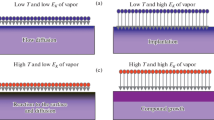Abstract
The formation of metal microstructures on metal substrates is theoretically analyzed by the example of local silver electrodeposition, using the numerical simulation of interrelated electrochemical and homogeneous chemical reactions. The silver electrodeposition localization and rate are shown to depend on the interrelation between full concentrations of ammonia, silver, and protons in solution. The ammonia relative concentration range is determined, which provided an acceptable combination of the silver electrodeposition localization and rate. By using some simplifications, the distributions of the concentrations of the participants in the reactions and the current density of silver ion reduction are numerically calculated for various concentrations of solution components and interelectrode distances. The degree of localization of metal deposition is shown to depend on the distribution of the concentrations of electroactive silver cations and the non-electroactive complex of this metal near the anode. The deposition rate was found to depend nonmonotonously on the interelectrode distances, which can be explained by difficulties in the reactants’ delivery at small interelectrode distances and increase of the fraction of the silver electroactive ions diffusing toward solution bulk at large interelectrode distances.










Similar content being viewed by others
REFERENCES
Madden, J.D. and Hunter, I.W., Three-dimensional microfabrication by localized electrochemical deposition, J. Microelectromech. Syst., 1996, vol. 5 (1), p. 24.
Braun, T.M. and Schwartz, D.T., The emerging role of electrodeposition in additive manufacturing, Electrochem. Soc. Interface, 2016, vol. 25 (1), p. 69.
Davydov, A.D. and Volgin, V.M., Electrochemical local maskless micro/nanoscale deposition, dissolution, and oxidation of metals and semiconductors (a review), Russ. J. Electrochem., 2020, vol. 56 (1), p. 52.
Xinchao, L., Pingmei, M., Sansan, A., and Wei, W., Review of additive electrochemical micro-manufacturing technology, Int. J. Mach. Tool. Manu., 2021, Art. 103848.
Han, L., Sartin, M.M., Tian, Z.Q., Zhan, D., and Tian, Z.W., Electrochemical nanomachining, Curr. Opin. Electrochem., 2020, vol. 22, p. 80.
Volgin, V.M., Kabanova, T.B., and Davydov, A.D., Modeling of local maskless electrochemical deposition of metal microcolumns, Chem. Eng. Sci., 2018, vol. 183, p. 123.
Morsali, S., Daryadel, S., Zhou, Z., Behroozfar, A., Baniasadi, M., Moreno, S., Qian, D., and Minary-Jolandan, M., Multi-physics simulation of metal printing at micro/nanoscale using meniscus-confined electrodeposition: Effect of nozzle speed and diameter, J. Appl. Phys., 2017, vol. 121 (21), p. 214305.
Meltzer, S. and Mandler, D., Microwriting of gold patterns with the scanning electrochemical microscope, J. Electrochem. Soc., 1995, vol. 142. p. L82.
De Abril, O., Mandler, D., and Unwin, P.R., Local cobalt electrodeposition using the scanning electrochemical microscope, Electrochem. Solid-State Lett., 2004, vol. 7, p. C71.
Hirt, L., Gruter, R.R., Berthelot, T., Cornut, R., Voros, J., and Zambelli, T., Local surface modification via confined electrochemical deposition with FluidFM, RSC Adv., 2015, vol. 5, p. 84517.
Hirt, L., Ihle, S., Pan, Z., Dorwling-Carter, L., Reiser, A., Wheeler, J.M., Prolenak, R., Voros, J., and Zambelli, T., Template-free 3D microprinting of metals using a force-controlled nanopipette for layer-by-layer electrodeposition, Adv. Mater., 2016, vol. 28, p. 2311.
Feng, Z., Xie, Y., and Georgescu, N.S., High-Resolution Nanoprinting Approach through Self-Driven Electrodeposition, J. Electrochem. Soc., 2019, vol. 166 (1), p. D3200.
Ren, W., Xu, J., Lian, Z., Yu, P., and Yu, H., Modeling and Experimental Study of the Localized Electrochemical Micro Additive Manufacturing Technology Based on the Fluid FM, Materials, 2020, vol. 13 (12), p. 2783.
Borgwarth, K., Ricken, C., Ebling, D.G., and Heinze, J., Surface characterisation and modification by the scanning electrochemical microscope (SECM), Ber. Bunsenges. Phys. Chem., 1995, vol. 99, p. 1421.
Borgwarth, K. and Heinze, J., Increasing the resolution of the scanning electrochemical microscope using a chemical lens: Application to silver deposition, J. Electrochem. Soc., 1999, vol. 146, p. 3285.
Radtke, V. and Heinze, J., Scanning electrochemical microscopy as a versatile tool for modifying surfaces, Z. Phys. Chem., 2004, vol. 218 (1), p. 103.
Ufheil, J., Hess, C., Borgwarth, K., and Heinze, J., Nanostructuring and nanoanalysis by scanning electrochemical microscopy (SECM), Phys. Chem. Chem. Phys., 2005, vol. 7 (17), p. 3185.
Radtke, V., Hess, C., Souto, R.M., and Heinze, J., Electroless, electrolytic and galvanic copper deposition with the Scanning Electrochemical Microscope (SECM), Z. Phys. Chem., 2006, vol. 220 (4), p. 393.
Newman, J.S., Electrochemical Systems, Englewood Cliffs, NJ: Prentice Hall, 1973.
Sukhotin, A.M., Handbook of Electrochemistry, Leningrad: Khimiya, 1981.
Frank, M.J., Kuipers, J.A., and van Swaaij, W.P., Diffusion coefficients and viscosities of CO2 + H2O, CO2 + CH3OH, NH3 + H2O, and NH3 + CH3OH liquid mixtures, J. Chem. Eng. Data, 1996, vol. 41 (2), p. 297.
Butler, J.N., Ionic Equilibrium: A Mathematical Approach, Reading, Mass.: Addison–Wesley, 1964.
Funding
The reported study was supported by the Ministry of Sciences and Higher Education of the Russian Federation and the Russian Foundation of Basic Research and the Tula Region according to the research project no. 19-48-710008.
Author information
Authors and Affiliations
Corresponding author
Ethics declarations
The authors declare that they have no conflict of interest.
Additional information
Translated by Yu. Pleskov
Rights and permissions
About this article
Cite this article
Volgin, V.M., Kabanova, T.B., Gnidina, I.V. et al. Modeling of the Metal Microstructure Formation by Local Electrodeposition onto Conducting Substrates. Russ J Electrochem 59, 635–645 (2023). https://doi.org/10.1134/S1023193523090112
Received:
Revised:
Accepted:
Published:
Issue Date:
DOI: https://doi.org/10.1134/S1023193523090112



